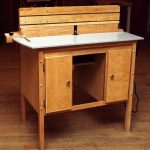We may receive a commission when you use our affiliate links. However, this does not impact our recommendations.

I’ve always resisted adding wheels or a mobile base to my workbenches. They can be complex, in the way of your feet and take some fiddling to engage and disengage.
So we’ve always put our benches up on furniture dollys when we needed to move them.
However, readers have pestered me for years now for ideas on how to make their benches mobile. Most of these people work in a garage workshop where they need to have everything on wheels so it can be pushed aside for the spouse’s car.
They never take me up on my first solution, divorce.
So I offer this idea. I’ve never seen it before, but I’m sure someone, somewhere has done it already. It’s based on a “Shortcut” we published years ago as a way to raise and lower your workbench. But instead of swinging a big block of wood under the feet to raise the bench, I decided to put four 3″ casters there.
I attached two 3″ casters each to two 1-1/2″ x 5″ x 24″ lengths of 2 x 6 that I trimmed up. Then I attached two unswaged utility hinges to each 2 x 6. One hinge for each leg. I had to saw out a 3/8″ x 3/8″ rabbet on the corner of each leg to receive the barrel of the hinge. Then I screwed the hinges to the legs.
I did this to Megan’s bench in about an hour today (that will teach her to leave the office to get a pedicure). Hope she likes it.
The video below shows just how fast this system works. In less than 30 seconds I put the bench up on its wheels and then down again onto the floor.
– Christopher Schwarz
Still More Workbench-related Links and Resources
– “Build an 18th-century Workbench” a new DVD with Christopher Schwarz. Buy this now at the pre-order price and I might win beer money. Seriously.
– See a reader’s solution to a mobile workbench that I posted here. Very cool. A little complicated for my taste.
– My DVD “The Workbench” (Lie-Nielsen Toolworks) shows you how to modify your workbench to improve its workholding abilities.
Here are some supplies and tools we find essential in our everyday work around the shop. We may receive a commission from sales referred by our links; however, we have carefully selected these products for their usefulness and quality.









This is SO much better than the way I did it. I modified the workbench plans that I had to use 4×4’s for the legs so that I had a mount for the casters. Live and learn, this way is so much easier.
I can say that the 4×4 legs did work well and I’ve used it like this for many years. I’ve had 400 pounds or more on the bench and it held steady.
You mean she not there as some part of a diversity program.
The prevailing thought is that her applying a screwdriver to remove the casters is the best of all possible outcomes for Chris, if she doesn’t like having casters put on her bench. It’s assumed that she’s not a helpless waif, or she wouldn’t be an editor at a woodworking magazine.
Is the prevailing thought here that Megan is unable to operate a screw driver and remove Chris’ improvement?
Norm’s way is better.
And Megan is going to go "ground combat" all over you.
Sorry dude, my money is on her.
This is a a nice simple solution. I agree with Michael about spring hinges to retract the casters or a small spring middle of the caster board to the strecher. Simply lifting the bench would clear the casters to the retracted position. It would address the concern of toe trap. I don’t see any significant possibility of a toe trap kicking the casters in plac as Chris does in the video. His foot is only under the assembly once the casters are under the legs and strecher. As Chris says, gravity and the casters are then protecting his foot.
Re: "That will teach her"
Naw… Put a set on her office desk as well, and then make sure she spends a morning each week hunting for her desk and bench. THAT will "teach her!" 😉 You’ve got to live life on the edge.
Rainer (and I’m sure they’re very pretty feet…)
Messin’ with a woman’s bench though, that could end very badly. You’re gonna come in one day and find your bench painted pink.
I couldn’t swing the caster to the inside of the bench because they would hit the stretchers.
I could shift the casters in so they miss the stretchers, but I would need to extend my leg further to snag the plate when pulling it toward me.
This works. I’ll mod it again when I get bored.
Chris
Chris,
Great idea. Think I’d go for putting the hinges/wheels on the inside, a little more out of the way. But would that require re-positioning the stretchers, or interfere with using the leg vise?
Since moving my bench is only an occasional activity I’d rather be inconvenienced during moving rather than using the bench.
For now I, like you, use mover’s dollys (or is it dollies?).
Norm’s solution is more complicated, but not excessively so.
As for the toe trap, yes, it exists. It’s one of the least dangerous things in his shop, with the possible exception of hand saws. Because it’s hinged, it is unlikely to exert any serious pressure on his foot. Also, a hand-tool woodworker probably isn’t that worried about not being able to support that bench, or lift it if he slips. He’s only lifting about half the weight of that bench, which is less than his own weight. He didn’t build his own solid wood Roubo bench without being able to lift that.
M E M O
To: Christopher "There is no toe trap" Schwarz
Re: Yes, there is.
1) Advance the video to 0:22, and pause it there.
2) Assume the position as shown in the video, holding the bench a few inches above the ground with your arms, and with your right foot underneath the crosspiece, the caster wheels up and out.
3) Ensure that the tip of your right toe is roughly even with or slightly past the far edge of the crosspiece. (It looks like it’s about right in the video.)
4) Release the benchtop.
"Oh…THAT toe trap."
After the "Won’t someone marry this sawyer?" post and modding the bench in her absence, I’m wondering what the payback is gonna look like! Megan must be on her way to a doctorate in them (paybacks) by now and I fear you may be the recipient of her dissertation. 😉
I’d also be inclined to fit those contraptions to the inside of the bench, so they would be out of the way – and out of sight – when not in use. They would also be easier to kick away from beneath the bench when lowering back to the floor. That curly toe manoeuvre, hooking the wheels towards you, looks awkward. Even better, make them detachable.
Spring loaded hinges would kick the assembly back out from under the table and would only require a lift and drop to return the table to the floor. It would also save Megan’s pedicure and future ability to marry.
Clarification: By "lifting block", I mean a cleat. Maybe two one-foot(-ish) lengths of 2" x 4"s, stacked and glued to make a 4" (approx) thick block.
–GG
Good one!
Suggested mod: For those with uber-heavy workbenches, or just with difficulties lifting heavy things, hinge the board + castors to swing towards the **inside** of the bench. This would allow room on the outside of the stretcher to bolt a lifting block: slide a hyrdraulic car jack under the lifting block, then swing the board + castors into/out of position.
–GG
There was this saying in the Army… If you ain’t cheatin’, you ain’t trying. By cheating I mean (as the Drill Sgt. Explained.) You adapted, overcame, and improvised. You have inspired me to do something similar.
There is no toe trap — thanks to gravity.
I’ve seen Norm’s solution. It has MacGyver written all over it. Add some rubber bands, a gerbil and a bobby pin and I think you will create cold fusion.
I’m not dissing Norm. Just pointing out that string is not simple.
Chris
Chris,
Rather than play footsie with the casters, you could rig them inside the legs and use a system like Norm did on his work table:
http://www.newyankee.com/getproduct.php?0207
When you want to move the bench around, you simply lift up each end and they drop down. To immobilize it, pull on the string and the bench settles with a thud.
Solves the pedicure problem. 🙂
J.
The toe trap would ruin my pedicure, you know.
I wouldn’t want to be in your shoes (literally) when you lost your grip on the bench top while attempting to lower the bench onto its legs.
You would do well to modify the crossbar design to eliminate the "toe trap"…
Chris, aside from putting wheels on your bench being sacrilege, all you’ve demonstrated is that your bench clearly isn’t heavy enough. Your bench should be at least heavy enough to require three people to lift one end. 🙂
Norm did something similar to one of his workbenches that doesn’t require you to put your foot to position the wheels.
Very clever, but please don’t do this to my bench when I’m not looking. In fact, I think it takes a big man (or woman) to admit that they willingly installed these!
Seriously, this is a great solution for the mobil shop. We have a situation where we have to move a bench a couple of hundred feet every so often and then return it for storage. This could be the answer.
WHEEE-INDEED!
That’s brilliant in the most stupid-simple sort of way!
Im totally modding my mcmaster-franken-bench asap.
Chris,
Admit it; you know you wanted to push that work bench out the doors, into the street, and take it for a ride.
Let us know how the LVL handles on the asphalt.